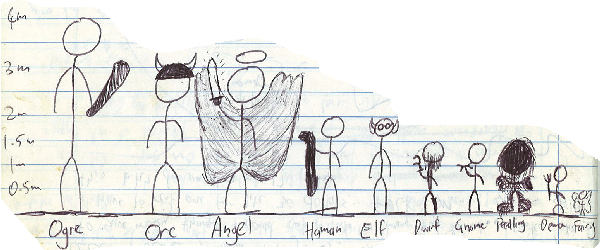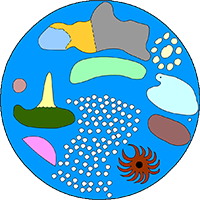According to Kevin Smith, a writer “creates his ideal world”. In the world of Kevin Smith films, people talk in lengthy monologues about pop culture and sex. That’s why the good guys win most of the time, "nice guys" get the girl, and everyone in movies is so attractive.
People create the world they want to live in and hope that others enjoy it as much as they do.
All my work on All-That-Is has been written with myself as the target audience. If I thought something was cool, would be interesting, would solve a problem I have with the Dungeons and Dragons universe (or fictional universes in general), or would be fun to play, I’d throw it in.
Bits and pieces are also based on various public domain works (The Wizard of Oz, Peter Pan) and others are (much less directly) inspired by works that aren’t public domain.
One of the most interesting series of articles I’ve ever read was by Rich Burlew, the man behind Order of the Stick. (a webcomic set in a world that obeys Dungeons and Dragons rules, but is not necessarily a game of Dungeons and Dragons.) The series of articles was called “The New World“; it’s an (unfinished) account of him creating a new campaign setting, writing stream-of-consciousness, explaining his decisions as he makes them, and giving general universe-building advice.
I’ve been working on All-That-Is for literally years now, so I don’t even know why some of the decisions were made, but I’ll share the thinking behind the parts that I remember. Over the years, I’ve bounced more than a few ideas off people – most notably my cousin Gavin, my friend Damon, and my sister Elizabeth. Without their input, All-That-Is would be quite a different world.

Exhibit A in the case of "Peter is not an artist".
This is a sketch from 2006, when I first started working on the world. It really wasn't meant to be seen by eyes other than my own, but it nicely demonstrates the size differences between the races.
There are exactly 10 sentient races in All-That-Is.
In Dungeons and Dragons, not only are there the base races that come with the rulebooks, but you can buy dozens of supplementary books, full of more playable races. What’s more, a huge number of the enemies you fight are sentient as well. Reading through the monster manual (or, honestly, playing a standard adventure) it feels like you’re living in a world where you can’t go ten metres without running into a new self-aware, intelligent race.
It also brings up a few moral problems - it's always strange to play a "Good" character who has no problem murdering an entire town full of kobolds or goblins, casually killing children and unarmed men and women alike.
The alternative, of course, is to let them live, which doesn’t really make sense either.
In All-That-Is, I decided to simplify it – there are exactly 10 sentient races, and 20 ways to blend them.
There aren’t more races on other planes, there aren’t more races coming out in later handbooks, and any group of creatures terrorising a village is either going to be one of these ten races (making killing them a legitimate moral choice) or a non-sentient race that you can slaughter without feeling guilty. (if you’re the sort of person who feels guilty killing fictional people.)
I’ll be using the word “people” a lot in this piece – a “person”, in All-That-Is, simply means “a member of a sentient race”, with people being the plural.
I’ll be making a lot of comparisons to “humans” – this could be confusing because Humans on All-That-Is are different to humans on earth. To make comprehension easier, whenever I say “humans” with a lowercase H, I’m referring to regular-brand Earth humans, and whenever I use a capital H, I’m referring to All-That-Is Humans (which is in keeping with my habit of capitalising All-That-Is race names anyway).
Similarly, if I’m comparing All-That-Is Dwarves to regular-style fantasy dwarves, or halflings, or gnomes, I’ll use capitals for All-That-Is races, and lower-case for all others.
Halflings
I have never liked halflings – I don’t like the name, and I don’t like the race.
Halflings were popularized by Dungeons and Dragons. They're a race who are Hobbit rip-offs at best, or - the way they’re described in the handbooks - short humans. They have almost nothing that makes them individual or unique, they’re just short humans with minor differences in personality and hairier feet. If you want to play a human but shorter, you play a halfling.
In All-That-Is,”Halfling” is a name for any blend between two races. “Half-elves” aren’t a race of their own, they’re simply a Human/Elf halfling. The races are split between 6 different sizes (Ogres are the largest, Fairies are the smallest) and any race can cross-breed with members of a race the same size, or one size smaller or larger.
While any individual Halfling’s culture is dependent on their parents, where they were raised, etc, they also tend to have an affinity for other Halflings. Most towns have a Halfling bar or club, where they can meet and associate with other Halflings without the prejudice that they regularly face from “normal” people. Halflings commonly become travellers (the All-That-Is term for "adventurers"), because they don’t really feel that they fit in anywhere*.
*the entire world of All-That-Is has origins in an RPG system, and so when I was coming up with the races, I tried to come up with specific reasons each race would be interested in adventuring.
Peedlings
To replace traditional halflings, I included a race called “Peedlings” - a small, charismatic race entirely covered in hair. They have disproportionately large heads, hands, and feet, and skinny arms and legs.
Peedling hair comes in all the colours that human hair comes in – brown and black are the most common, there’s an occasional blonde and the much rarer redhead. Clothes are optional, but Peedlings in situations where loose hair could be a risk (such as, say, adventuring) tend to wear protective garments and tie their hair back wherever it’s longest (or - less commonly - cut it off).
Peedlings are the entertainers of the world; the vast majority of the great writings, paintings, songs, dances and plays of the world have come from Peedlings, and their culture is entirely based around culture.
Peedlings suffer from an artistic temperament. This invariably makes them restless – a Peedling rarely stays in one city for their whole life, preferring to see the world, draw inspiration from life, and have adventures that they can work into creative pieces.
Fantasy city by David Revoy, licensed under the
Creative Commons Attribution 3.0 Unported license.
